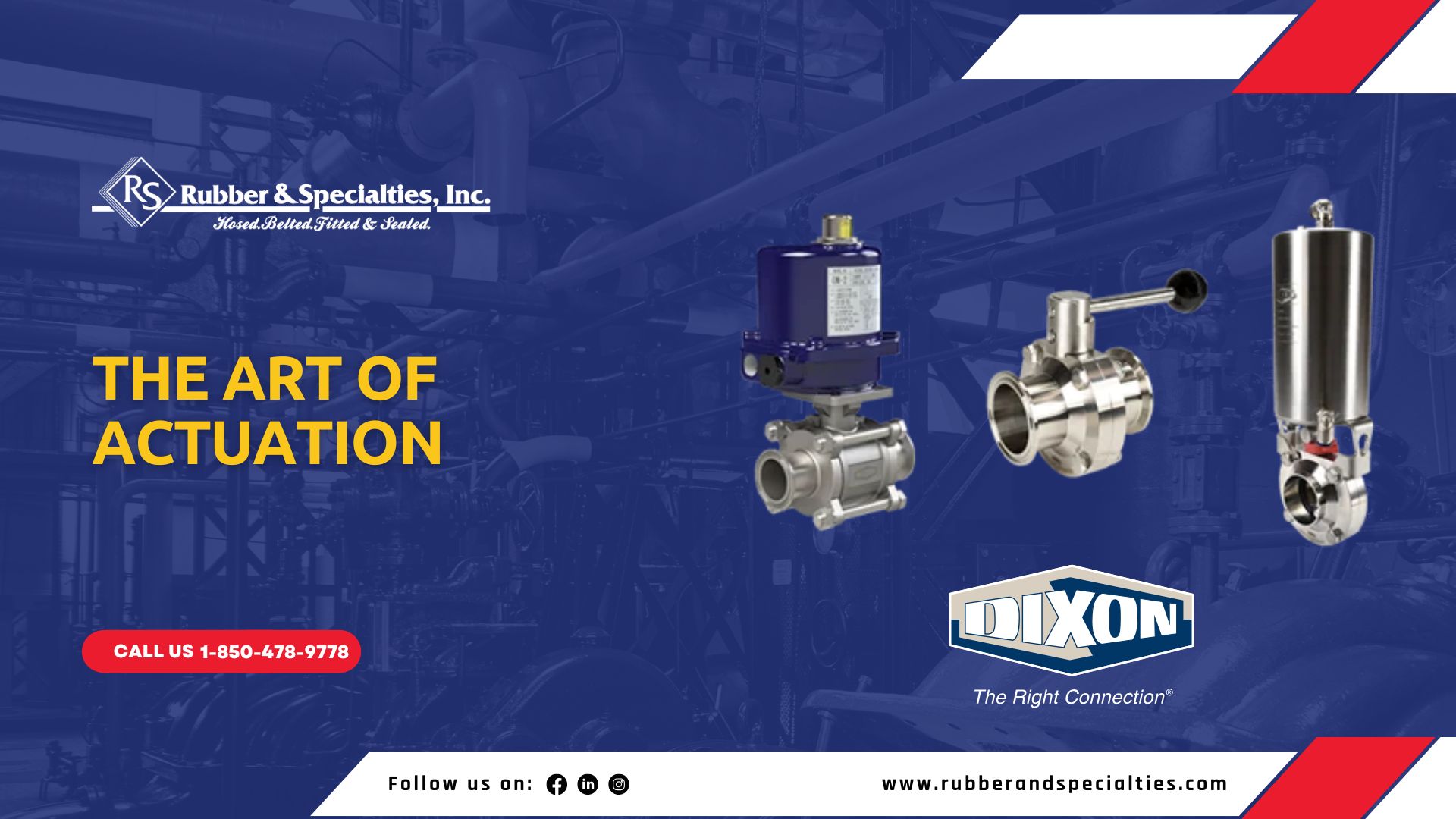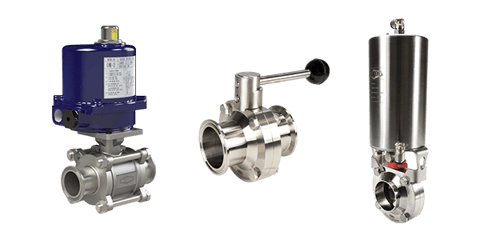
The Art of Actuation
August 23, 2023

What goes up must come down, and what opens must be closed. Although the former was used by Sir Isaac Newton to explain gravity, the latter is also true; especially when it comes to valves. Valves must be opened and closed to allow fluid to start and stop moving through a system. The easiest, most efficient way to do this is with actuation.
What is Valve Actuation?
An actuator is a mechanism that controls the positioning of the valve. This can be done manually with a handle or using an automated device. Automated devices are typically powered by an electric motor or pneumatic cylinder. The idea is to remove human contact or error and add efficiency and accuracy to the application.
Benefits of Automated Valve Actuation
Valve actuation is beneficial in a variety of situations. For example, if a valve needs to be opened and closed frequently, an actuator makes the process more efficient. A valve may be in a hard-to-reach place, or there may not be enough plant personnel to repeatedly open and close the valve in a timely manner. If the valve is in a hazardous location, it is important to be there as little as possible. A valve actuator helps with this. In addition, valve actuators can help control multiple valves, which is important with clean-in-place (CIP) systems. After completing a batch run you want to move cleaning fluid, like an acid, through the system. Then, you want to be able to stop that fluid flow and introduce another fluid. Using a valve actuator offers better control and reduces the potential for human error when it comes to opening and closing the valve.
Types of Valve Actuators
There are three main types of valve actuators: manual, electric, and pneumatic.
Manual Actuators
Manual actuators can be lever type, trigger type, gear operators, handwheels, or deadman handles. Feedback options are available on some manual operators. With a handle, the valve is manually operated to open, close, or modulate flow.
Deadman handles have a spring inside that closes the valve when the handle is released. This prevents someone from accidentally opening a valve and then forgetting or not being able to close it.
Feedback options provide remote indication that the valve is open or closed.
Electric Actuators
Electric actuators use electrical energy to open and close a valve. They can rotate 90°, are constructed with powder-coated aluminum, and have power-open and power-close actions with a standard 35% duty cycle.
Options:
- 24, 120, 220 volts alternate current (VAC) and 12, 24 volts direct current (VDC)
- Input/output modulating control: 4-20mA, 1-5V, 2-15V
- Feedback switches built-in
- Local control units
- Manual overrides
Pneumatic Actuators
Pneumatic actuators use air to open a valve. Pneumatic actuators can be spring return or double acting. With a spring return actuator, air opens the valve and the spring pushes the valve closed. This differs from a double-acting actuator where air is used to open and close the valve. Two of the pneumatic actuators Dixon offers are rack and pinion and vertical canister.
Rack and Pinion Actuator
Rotation:
- 90° or 180°
Materials:
Rack and pinion actuators can have a variety of additional options, including limit switches, NAMUR solenoids, and positioners.
Limit switches provide feedback and visual indication of the valve position via mechanical or proximity sensors and a beacon indicator.
NAMUR solenoids are connected directly to the pneumatic actuator NAMUR interface. A direct mount solenoid gives the ability to electrically control a pneumatic valve with various voltage options. The solenoid can be NEMA 4/4X standard waterproof or NEMA 7/9 explosion-proof.
Positioners work in relation to an actuator and the programmable logic controller (PLC). The positioner is mounted to the actuator pinion or linear detection shaft. A signal is sent to the positioner from the PLC to produce a desired percentage of valve position. The degrees of opening range from 0% to 100%. There are electro-pneumatic and pneumatic options with 4-20mA, 0-10V, Profibus, DeviceNet, AS-Interface, or 3-15 PSI input respectively.
Vertical Canister Actuator
Rotation:
- 90°
Material:
- Stainless steel
Vertical canister actuator options include Burkert control tops and proximity sensors.
Dixon offers two types of Burkert control tops: type 8691 and type 8692. Type 8691 indicates valve position with a contact-free analog sensor element. It features up to two integrated pilot valves. Type 8691 is compatible with As-interface, I/O link, and DeviceNet communication networks.
Type 8692 has 4-20 mA control, a digital interface, and 4-20 mA feedback. This type of Burkert control top is also compatible with As-interface, I/O link, and DeviceNet communication networks.
Proximity sensors come in 10-30 VDC or 20-253 VAC. They can be shielded or unshielded and have a 2-15 mm sensing range.
Sanitary vs Industrial Valves
Dixon assembles actuators for both sanitary and industrial valves. While sanitary and industrial valves serve the same general purpose, they differ in construction materials and applications. Read our Sanitary vs Industrial Valves blog post to learn more.
Pneumatic vs Electric Valve Actuators
With an approximate 1-second response time, pneumatic valve actuators are quick acting. Electric valve actuators, however, are slow moving with 15 seconds being the fastest rotation time. Pneumatic actuators can be spring return or double acting, while electric actuators require power to move the valve both ways. If larger torque is required, a large pneumatic actuator is needed, whereas an electric actuator can provide large torque in a small package. Lastly, the controls and feedback are external for pneumatic actuators and internal for electric actuators.
Valve Actuator Accessories
Wherever there are valve actuators there are a plethora of accessories, too. Whether it’s tubing, push-to-connect fittings, food-grade lubricant, FRLs, or gauges, Dixon has everything you need to make The Right Connection®.
Tips for Selecting a Valve Actuator
Choosing the proper valve actuator depends on the application. Factors such as power source, speed, torque, number of cycles, size, temperature range, and area classification. Learn more about how to select a valve actuator in this blog post.
Why Choose Dixon?
Whether it’s for clamps, pumps, or another hygienic fluid transfer product there are numerous reasons to choose Dixon.
Specifically, when it comes to valve actuators, there are four main reasons why Dixon is your best choice: U.S. assembly, quick delivery, product testing, and service.
All Dixon sanitary and industrial ball and butterfly valves are actuated in Pewaukee, Wisconsin, which upholds Dixon’s commitment to being a proud U.S. manufacturer and supplier. Our inventory and strategically organized assembly cells optimize efficiency and allow for rapid turnaround with 1-3 day lead times on most assemblies. The valves are built and tested in our facility before shipping to ensure quality and safety. Last, but certainly not least, Dixon offers customer service that supports our customers before, during, and after the sale. Contact us for more information about our valve actuation capabilities.
SOURCE: The Art of Actuation






